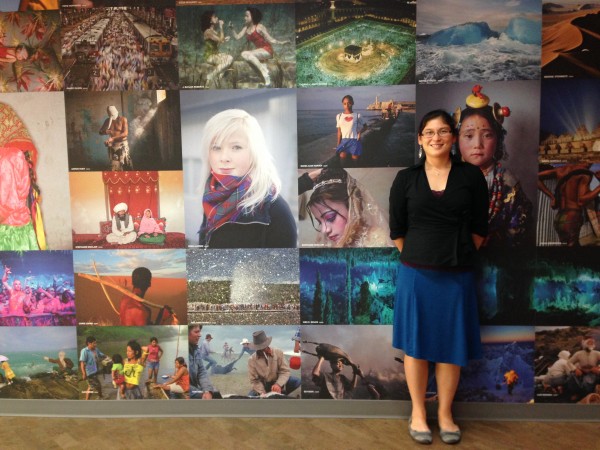17 July 2015
Falling in love with science all over again as a PhD-turned-journalist
Posted by mcadams

Maya Wei-Haas poses at her desk at National Geographic, where she is working as a science reporter for 10 weeks this summer as the 2015 AGU-sponsored Mass Media Fellow. Photo by Greta Weber.
By Maya Wei-Haas
“Please, please, please,” repeats in my mind. At least five other ideas were turned down this week, and I am on my third round of explaining this story idea, receiving my third, “I don’t think so,” from Mark Strauss, one of the quirky and brilliant editors at National Geographic. It’s 6:00 p.m. on a Friday afternoon. The office is nearly empty, the lights mostly off.
But then, he hesitates. “Well,” he says before caving to the pitch—or rather my re-pitch—about redefining the mass of a kilogram. “I can’t guarantee we’ll post it.” But that doesn’t matter to me at the moment. I had what I needed: A chance to write my next piece.
I am a scientist turned writer, currently 5 weeks into a 10-week AAAS Mass Media Fellowship sponsored by AGU. This crash course entry into journalism is an exhilarating and exhausting ride.
At the start of summer, I was terrified to talk to scientists and other seasoned writers, not to mention pitching story ideas to editors. As a doctoral student, I rarely interacted with large numbers of people. Living in a world of e-mails and lab work, multiple days could pass before I spoke to any others except my husband.
In fact, I never summoned an expert on that terrifying thing called a phone only because I didn’t know something.
Unexpectedly, interactions with scientists are among the most enjoyable parts of the job. After one interview with a paleontologist studying Precambrian organisms, all I wanted to do was study organism evolution and paleontology. His passion for the research was infectious.
This summer also reawakened my curiosity for all science. At the end of my PhD, I was so desperate to graduate I had tunnel vision and lost my desire to explore science for fun. But researching and writing about a wide range of concepts—from modern animal behavior and adaptations to Cambrian geology—reminded me how fun it is to take a back seat to your curiosity.
A big part of this reawakening has come from writing articles about viral photos or video: Highlighting the science behind popular topics ranging from the adorable to the horrific. When writing these articles I let my mind wander, track down interesting details, and let the story move in whatever direction the interviews and research dictates.
One of my favorite viral content stories involves pictures of a chameleon that needed help to break out of its shell. The photographs are captivating: Tail tucked over its shoulder, this tiny creature is curled in a tight ball, unaware it’s no longer confined to a shell.
Though I loved the images, I wasn’t sure what to write because the details behind what happened were straightforward. I nervously entered into interviews with chameleon experts without prepared questions, but from our conversations a story emerged of the chameleon’s journey out of the egg—which is no small feat—and the struggles of captive animal breeding.

Maya Wei-Haas stands in front of the National Geographic photo wall in Washington, D.C. Photo by Greta Weber.
Selecting the most relevant and interesting details to focus on in each story or pitch poses my biggest challenge this summer. As a scientist, I feel compelled to mention caveats and similar studies in my stories. But I am learning (albeit slowly) too many caveats and asides dull other people’s excitement for a topic. When pitching a story idea to one of my editors, I often hesitate to proclaim, “This is an amazing story because…” But if I can’t excite him or her with a story idea, I won’t get the chance to excite readers with it either.
This is how I found myself re-pitching a story to an extremely patient editor that Friday night. I went home beaming that day, eager to spend the weekend pouring through documents about physical constants in nature. I knew this article would challenge me, but could see there was an engaging story somewhere in the haze.
I didn’t doubt the edits Mark gave me would be extensive, but another big lesson for the summer is expressed most eloquently by William Zinsser who wrote: “Rewriting is the essence of writing.” Journalism is much like science in this respect, since science is the art of retesting. It’s all part of the process.
The reworked and revised version, Elusive Quest for One True Kilogram Finally Pays Off, was finally posted on Thursday.
I can’t wait to keep writing and am ever grateful to AAAS and AGU for this chance to fall in love with science all over again as a journalist.
— Maya Wei-Haas is AGU’s 2015 Mass Media Science and Engineering Fellow. She is spending her 10-week fellowship at National Geographic in Washington, D.C. Wei-Haas earned her Ph.D. in geology from Ohio State University this May. Click here to read her stories from the National Geographic newsroom.


 The Plainspoken Scientist is the science communication blog of AGU’s Sharing Science program. With this blog, we wish to showcase creative and effective science communication via multiple mediums and modes.
The Plainspoken Scientist is the science communication blog of AGU’s Sharing Science program. With this blog, we wish to showcase creative and effective science communication via multiple mediums and modes.